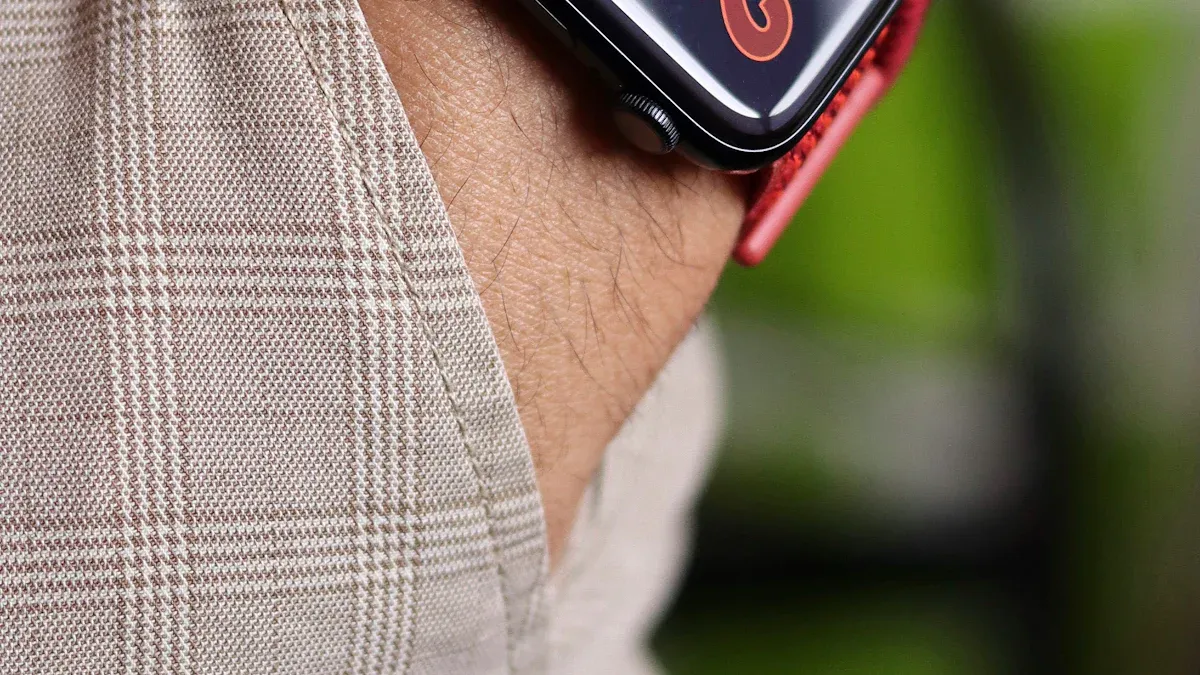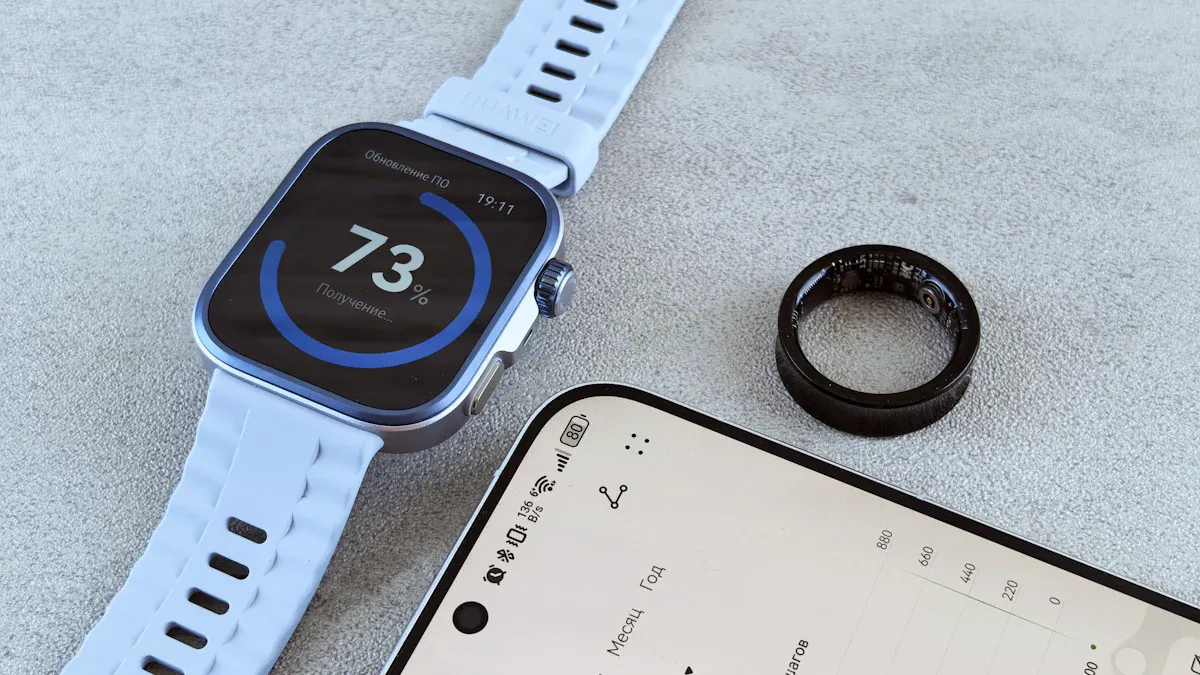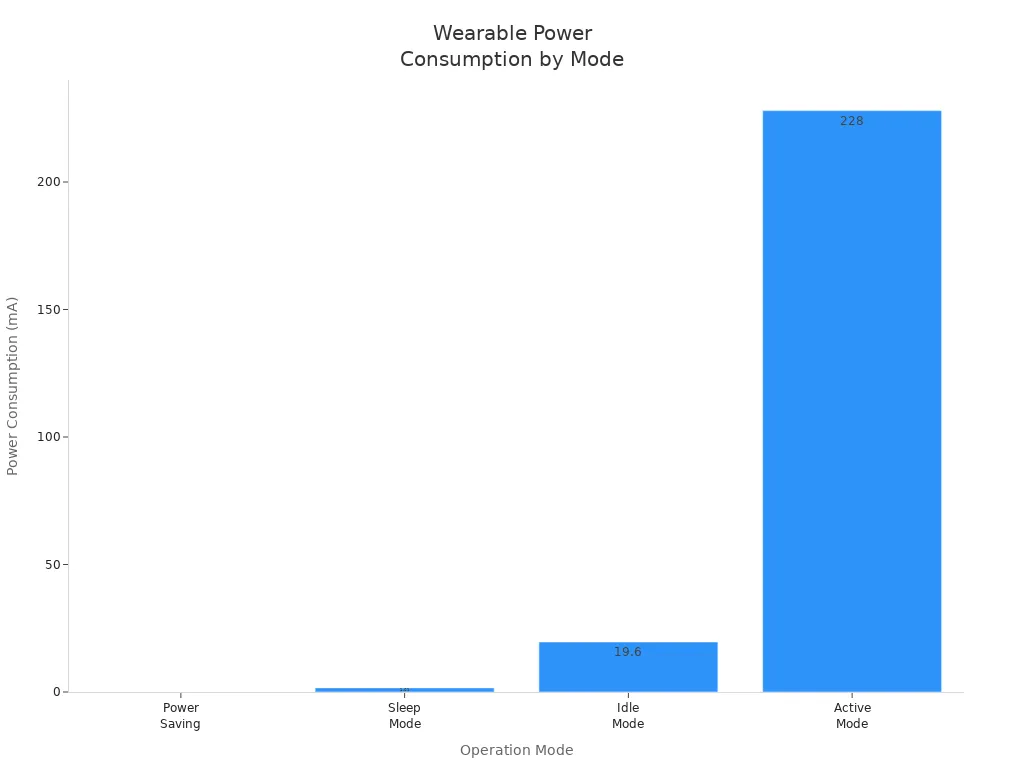
Small lithium polymer batteries power most modern wearable technology. These batteries fit inside slim devices like smartwatches and health trackers. Manufacturers choose lithium polymer batteries because they combine high energy density (130–200 Wh/kg) with flexible shapes, making them ideal for compact, lightweight devices. Most wearable devices rely on these batteries for long runtimes without adding bulk. In 2024, the global market for small lithium polymer batteries reached $1.65 billion, with more than 65% of wearable models using flexible lithium polymer battery packs thinner than 1 mm. The unique balance of weight, size, and performance sets these batteries apart for wearable technology.
Lithium Polymer Batteries in Wearables

Caractéristiques principales
Lithium polymer batteries stand out as high-performance power sources for wearable technology. These batteries offer several features that make them ideal for wearables and IoT devices:
- High energy density: Lithium polymer battery cells store a large amount of energy in a small space. This feature allows devices to run longer without increasing their size or weight.
- Lightweight and compact design: Lipo batteries weigh very little and fit into slim, small spaces. This makes them perfect for compact and lightweight design in wearable devices.
- Mechanical flexibility: The flexible structure of a lithium polymer battery lets it bend and stretch. Manufacturers can cut the battery to custom shapes and sizes, fitting curved or irregular surfaces in wearables.
- Long cycle life: Lipo batteries last through many charge and discharge cycles. This durability means wearable devices stay reliable over time.
- Fast charging capability: Users can recharge their devices quickly, reducing downtime.
- Safety features: Battery management systems, protective coatings, and flame-retardant additives help prevent hazards like thermal runaway.
- Customization: The flexible laminate enclosure of a lithium polymer battery allows for easy adaptation to different device shapes. This supports creative designs in wearable technology.
Note: The flexibility of lithium polymer batteries enables manufacturers to create thinner, lighter, and more comfortable wearables. This adaptability supports the development of smart clothing, wristbands, and medical sensors that fit the body naturally.
Benefits for Wearables
Lithium polymer batteries bring many advantages to wearable technology. These benefits help explain why lipo batteries have become the preferred choice for powering modern wearable devices:
-
Thin, Lightweight, and Flexible Design
Lipo batteries use a polymer electrolyte, making them thin and flexible. This allows them to fit into compact wearable devices and support new form factors, such as smart clothing and curved wristbands. -
Densité énergétique élevée
A lithium polymer battery provides more power for its size and weight than most other batteries. This means wearables can operate longer between charges, even as they become smaller and lighter. -
Safe and Stable Chemistry
The solid or gel-like electrolyte in lipo batteries reduces the risk of leaks or ruptures. This safety is important for devices worn close to the skin. -
Fast Charging and High Efficiency
Lipo batteries support quick charging and efficient energy use. Users spend less time waiting for their devices to recharge. -
Reliable Performance in Extreme Conditions
Lithium polymer batteries maintain stable performance across a wide range of temperatures. This reliability makes them suitable for outdoor and active use. -
Flexibilité de la conception
Manufacturers can customize the shape and size of a lithium polymer battery to fit slim, irregular, or curved devices. This flexibility supports creative and ergonomic wearable designs. -
Long Cycle Life
Lipo batteries last through many charge cycles, making them durable for daily use in wearables.
| Paramètres | Piles au lithium polymère | Lithium-Ion Batteries |
|---|---|---|
| Durée de vie (cycles de charge) | 1500-2000 | 500-1000 |
| Densité énergétique (Wh/kg) | 300-400 | 150-250 |
| Type d'électrolyte | Gel-like or solid-state | Liquid |
| Self-Discharge Rate | <1% par mois | 2-3% par mois |
The table above shows that lithium polymer batteries outperform traditional lithium-ion batteries in cycle life, energy density, and self-discharge rate. These qualities make them the best choice for slim, lightweight wearable devices that need long-lasting power.
High energy density and lightweight characteristics are critical for wearable and IoT device performance. These features allow devices to remain small, comfortable, and easy to wear while providing longer battery life. Flexible and bendable lipo batteries support innovative designs, such as smart clothing and medical wearables, which need stable power even when bent or stretched.
Tip: As wearable technology advances, the demand for compact, flexible, and long-lasting batteries will continue to grow. Lithium polymer batteries meet these needs, enabling the next generation of wearable and IoT devices.
Small LiPo Batteries and Device Performance
Battery Powering Wearable Electronics
Small lipo batteries play a central role in battery powering wearable electronics. These batteries allow engineers to design portable electronic devices that are slim, lightweight, and comfortable to wear. A lithium polymer battery fits into the smallest spaces, making it possible to create smartwatches, fitness trackers, and wearable medical devices that users can wear all day. Lipo batteries deliver haute densité énergétique, which means they store a lot of power in a small package. This feature supports continuous operation and real-time monitoring in many wearable technology products.
The power needs of wearable devices change based on their function and mode. For example, a smartwatch may use very little power in sleep mode but much more during active use. The table below shows how power consumption varies in different modes and how small lipo batteries meet these needs:
| Mode | Power Consumption (mA) | Notes |
|---|---|---|
| Power Saving | ~0.0032 mA (3.2 μA) | Lowest power mode |
| Sleep Mode | 0.61 – 1.61 mA | Depends on DRX/e-I-DRX settings |
| Idle Mode | 15.3 – 19.6 mA | Varies with DRX/e-I-DRX |
| Active Mode | 165 – 228 mA | At 21 dBm output power, GNSS off |
| Battery Capacity | 300 – 500 mAh | Estimated max capacity for 40x20x5 mm Li-Po battery volume |

Small lipo batteries provide enough energy for continuous monitoring and real-time data collection, even in compact devices. For example, fitness trackers use lipo batteries to track steps, heart rate, and sleep patterns without frequent charging. Medical monitoring devices, such as continuous glucose monitors and wearable heart monitors, rely on these batteries for continuous patient care and real-time alerts.
Note: Optimizing power modes and duty cycles helps extend the runtime of portable electronic devices, making small lipo batteries even more effective for powering wearable electronics.
Impact on Device Size and Runtime
The size of a lithium polymer battery directly affects the runtime and performance of wearable devices. Lipo batteries are thin and flexible, which allows manufacturers to design smaller, lighter, and more comfortable wearables. This flexibility supports the miniaturization of wearable medical devices, such as smart bandages and implantable monitors, which require both continuous operation and a discreet form factor.
A lithium polymer battery with higher capacity can power a device for a longer time. For example, smartwatches and fitness trackers often use lipo batteries with capacities between 300 and 500 mAh. This range balances compact size with enough energy for daily use. Advances in battery chemistry, like Lithium Cobalt Oxide, increase energy density, so devices can run longer without making the battery bigger.
| Wearable Device Type | Battery Demand Characteristics | Key Battery Features | Impact on Device Performance and Functionality |
|---|---|---|---|
| Smartwatch | Compact, multi-functional, slim design; moderate-high current; 1-3 days runtime | Thin/curved high energy density LiPo | Enables slim form factor, supports multiple functions, balances battery life and size |
| Fitness Tracker | Extremely small, lightweight, long wear; low-moderate current; 3-7 days runtime | Ultra-miniature, flexible LiPo | Provides comfort, long runtime, fits small and flexible designs |
| Hearing Aid | Micro, ultra-light, very low power; 1-3 weeks runtime | Micro/custom irregular shape LiPo | Meets extreme space limits, ensures ultra-long stable power and safety |
| AR/VR Glasses | High power, large capacity; high peak current; 2-4 hours runtime | High capacity/multi-pack LiPo | Supports high-performance computing, optimizes weight and heat management |
| Medical Sensor | Body-worn/implantable, high stability; weeks-months runtime | Custom ultra-thin/flexible medical-grade LiPo | Ensures biocompatibility, long-term stability, and safety |
Small lipo batteries enable continuous monitoring in wearable medical devices. For example, researchers at UC Berkeley have embedded ultra-small lithium polymer batteries into sensor circuits. This innovation allows for the creation of smart bandages and other medical wearables that combine sensors, microprocessors, and batteries into a single, thin chip. These batteries are as thin as three sheets of paper, making them ideal for continuous patient care and real-time health monitoring.
Other real-world examples include:
- Long-term blood pressure monitors: Use compact lipo batteries to provide continuous cardiovascular monitoring.
- EEG and sleep study systems: Rely on lipo batteries for portable, multi-channel monitoring over several nights.
- Asthma inhalers: Use small lipo batteries to power real-time monitoring and reminders for medication use.
- Continuous glucose monitors: Depend on lipo batteries for uninterrupted glucose tracking and alerts.
Lipo batteries also support the development of new wearable medical devices that require continuous operation, such as implantable monitors and smart patches. Their flexibility and high energy density allow for creative designs that improve comfort and usability.
Tip: Selecting the right lithium polymer battery for a wearable device involves balancing size, capacity, and safety. Manufacturers must consider the device’s power needs, expected runtime, and form factor to ensure reliable performance and user satisfaction.
Types and Form Factors

Miniature Lithium Polymer Battery Options
Lipo batteries come in many shapes and sizes to fit different wearable devices. Engineers select the right lithium polymer battery based on the device’s size, power needs, and design. The most common types include:
- Button (coin) cells: Small, round batteries often found in wearable medical devices like hearing aids and implants.
- Polymer (pouch) cells: Flexible, flat batteries sealed in foil pouches. These fit slim devices such as smartwatches and fitness trackers.
- Cylindrical cells: Less common in wearables, but some devices use them for their standard shape.
- Custom-shaped cells: Designed for unique devices, such as smart rings or curved smartwatch straps.
- Thin-film batteries: Extremely slim, these power microelectronics and implantable sensors.
Lipo batteries offer a wide range of dimensions and capacities. The table below shows how different lithium polymer battery types match the needs of wearable medical devices and other electronics:
| Battery Type / Application | Dimensions (mm) | Capacité (mAh) | Notes |
|---|---|---|---|
| Coin cell-sized LiPo batteries | ~10-15 diameter, few mm thick | Few mAh | Used in smartwatches, fitness trackers, wearable electronics |
| Medical device batteries | Few mm length & width, <1 mm thick | <1 mAh | For hearing aids, implantable sensors |
| Micro LiPo batteries (2024 series) | Diameter: 4.5 – 12, Thickness: 4 – 23 | 18 – 65 | Used in headsets, IoT, GPS, medical devices, Bluetooth headsets, smart toys, smartwatches |
| Tiny LiPo battery (GMB031009) | 3 x 9 x 10 | 8 – 12 | High C-rate, designed for wearable devices, high energy density, stable performance |
| Custom smallest LiPo battery | 0.6 thickness, 15 width, 34 length | 6 | Rechargeable, suitable for consumer devices |

Lipo batteries can be made very small and thin. This helps wearable medical devices stay light and comfortable for users.
Flexible and Pin-Type Variants
Flexible lipo batteries have changed how engineers design wearable medical devices. These batteries bend and twist, so they fit into curved or irregular spaces. Pin-type lipo batteries use special connectors, such as PC pins or solder tabs, to make assembly easier in small devices.
The table below compares flexible and pin-type lipo batteries:
| Feature/Aspect | Flexible LiPo Batteries |
|---|---|
| Densité énergétique | High (500–620 Wh/L) |
| Facteur de forme | Flat, lightweight, customizable, ultra-thin, flexible |
| Sécurité | Excellent, low leakage risk, built-in protection |
| Operating Temperature Range | Wide (-40°C to +85°C) |
| Cycle de vie | Limited (~500 cycles) |
| Coût | Higher than lithium-ion batteries |
| Risques | Swelling or fire if damaged/overcharged |
| Adéquation de l'application | Ideal for compact wearables and medical devices |
| Battery Terminations (Pin-type) | PC pins, SMT mounts, solder tabs, cables/connectors |
Flexible lipo batteries allow for creative designs in wearable medical devices. They support thin, lightweight products that stay comfortable during daily use. Pin-type lipo batteries make it easier to connect batteries to small circuit boards. However, flexible lipo batteries cost more than standard lithium-ion batteries. They also have a shorter cycle life and may swell if damaged.
Tip: Flexible lipo batteries help wearable medical devices stay small and comfortable. Pin-type connectors make battery assembly faster and safer.
Choosing a Lithium Polymer Battery
Factors to Consider
Selecting the right lithium polymer battery for a wearable device requires careful attention to several important factors. Designers must match the battery’s size and shape to the device’s form. The pouch construction of a lithium polymer battery allows for custom shapes, so it can fit into slim or curved spaces. This flexibility is especially useful in medical-grade wearables, where comfort and fit matter.
- Capacity determines how long the device can run before needing a recharge. Higher capacity means longer runtime, but also a larger battery.
- Voltage ratings, including operating and cutoff voltages, must match the device’s requirements to prevent damage.
- Les discharge rate, or C-rate, affects how quickly the battery can deliver power. High C-rates support features like wireless communication but may reduce battery life.
- Temperature can change how well the battery works. Low temperatures reduce capacity, while high temperatures can cause faster aging.
- Custom-shaped batteries may increase costs and require extra certification, such as UL or CE.
- Most lipo batteries are not user-replaceable. Devices need built-in charging, like USB or wireless charging.
Tip: Always check the manufacturer’s reliability and product life cycle, especially for medical-grade applications that need continuous monitoring.
Safety and Reliability
Safety is a top priority when choosing a lithium polymer battery for wearables. These batteries can pose risks if not handled or designed properly. Overcharging, punctures, or manufacturing defects may lead to overheating or even fire. Modern lipo batteries include protection circuits to prevent overcharge, over-discharge, and overheating. Devices should use strong housings to protect the battery from damage.
Common safety features include:
- Battery management systems that monitor voltage, current, and temperature.
- Physical protections like vents and thermal cutoffs.
- Certifications such as UL 1642, UL 2054, and IEC 62133, which show the battery meets strict safety standards.
| Standard/Certification | Description |
|---|---|
| UL 1642 | Safety for lithium cells |
| UL 2054 | Safety for battery packs |
| IEC 62133-2 | International safety for lithium systems |
| UN38.3 | Safe transport of lithium batteries |
| CE | European safety and health compliance |

Manufacturers use strict quality control and advanced engineering to ensure each lithium polymer battery is safe and reliable. Medical-grade batteries must pass extra tests for continuous use in sensitive environments. Proper storage, compatible chargers, and stopping use if the battery shows damage help keep users safe.
Note: Always choose certified, medical-grade lithium polymer batteries for medical-grade wearables to ensure continuous, safe operation.
Small lithium polymer batteries have transformed wearable devices by making them lighter, smaller, and more powerful. Recent research, such as biocompatible batteries for medical wearables, shows how these batteries support new health technologies. Their thin, flexible design and fast charging help create comfortable devices that last longer. When choosing a battery, users should look for safety, reliability, and the right fit. Future innovations, like solid-state et self-charging batteries, promise even better performance and more possibilities for wearable technology.
FAQ
What makes lithium polymer batteries ideal for wearables?
Lithium polymer batteries offer high energy density and a compact and lightweight design. These batteries fit into slim devices. Wearable technology benefits from their flexibility and ability to power portable electronic devices for long periods.
How do small lipo batteries improve medical-grade wearables?
Small lipo batteries enable continuous monitoring in wearable medical devices. They support real-time data collection for continuous patient care. Medical-grade batteries provide safety and reliability, which are important for medical monitoring and continuous glucose monitors.
Are lithium polymer batteries safe for powering wearable electronics?
Manufacturers design lithium polymer batteries with advanced safety features. Battery management systems and protective coatings help prevent overheating. Medical-grade wearables use certified batteries to ensure safety during continuous use.
Can lithium polymer batteries support high-performance power sources in IoT devices?
Lithium polymer batteries deliver high energy density for IoT and wearable technology. These batteries provide reliable power for high-performance power sources. Devices like smartwatches and fitness trackers use them for continuous operation and real-time monitoring.

